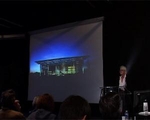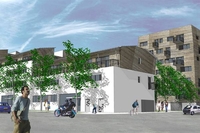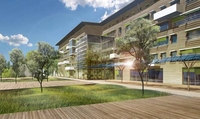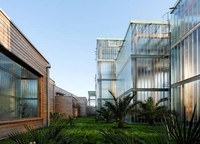Françoise-Hélène Jourda: "Towards a responsible architecture"

Françoise-Hélène Jourda believes that a building should be the result of research carried out involving everyone concerned including project management and users throughout the project design process. The final result is not the consequence of preconceptions and an isolated architect, but rather the concerted result of interrogations about local resources: "I don't know what my buildings will look like when I am working on them, I refuse to ask the question in stylistic terms, she says. Preparing for a competition is a difficult experience, because perspectives have to be shown. Consequently, the images that I present are illustrations rather than images of the building. These illustrations tell a story. But they are never an accurate depiction of the building. That is impossible until all the work has been done!"
Everything remains to be invented

In broadening the matrix of design criteria for a project so that it is not restricted to a statement of the form, uses and function, so-called sustainable architecture confuses plastic reference data. "Architecture is changing, says Françoise-Hélène Jourda. In a way, everything still has to be done." Obviously, today's aesthetic recognised criteria are not the same as they will be tomorrow. Under these conditions, only the meaning genuinely deserves consideration by Françoise-Hélène Jourda who also offers advice in sustainable development to technical commissions or local communities. In other words, relevance comes before form.
This search for meaning is expressed in a very wide variety of programs: a detached house in Lyon, for which a stretched fabric type umbrella covers an economic dwelling made of plywood, a botanical museum in Bordeaux in which large shotcrete pebbles introduce the visitor to a space dedicated to nature as he arrives, or an ultra-compact zero-energy office building in the Seine Saint-Denis Department (Paris suburbs). But Françoise-Hélène Jourda really got her basic training and experience between 1992 and 1999, with the manifest project of the Ministry of the Interior Training Academy in Herne-Sodingen, Germany. A large greenhouse clad with 10,000 sq m of photovoltaic cells shelters elements of the program, naturally recreating a micro-climate with an annual temperature curve similar to Nice, financed partly through European funds. The greenhouse structure is made entirely of seasoned wood cut from the nearby forest, while the assembly generates a peak of 1 MW for a very positive energy balance.
Compact and transformable buildings
Like the Herne-Sodingen project, Françoise-Hélène Jourda's work regularly includes features using wood cladding and structures, because it is "an excellent material for sustainable development" in her own words. The covered market in Lyon on Place du 8 mai 1945, 87 council houses in Rouen and rehabilitation of the Pajol Hall in Paris, are examples of a contemporary style architecture not necessarily dependent on the use of glass and steel as the only possible components. But the French-Austrian architect questions all existing construction and architecture practices more generally, beyond the question of grey energy in materials. Is it possible to create high energy efficiency buildings without making them compact? How to contribute to the development of developing countries like Morocco, with an environmental project of tourist residences?
The question of transformation of the planned zero energy building in Saint-Denis, and even its demolition before construction, has been discussed with the client. The building had to be independent of any given period. It had to be modifiable, dismountable and recyclable so that it could perform new functions and make the best reuse of resources used for its construction. With its 40 cm thick lightweight non-load bearing facades and its structure composed of steel columns and concrete slabs prefabricated so that they can be disassembled, Françoise-Hélène Jourda disagrees with the concept of permanence, thus substantiating the best understood definition of sustainable development: to allow future generations the possibility of satisfying their needs.



